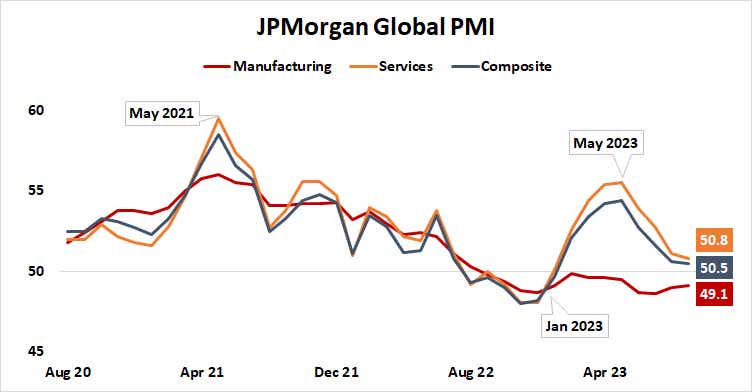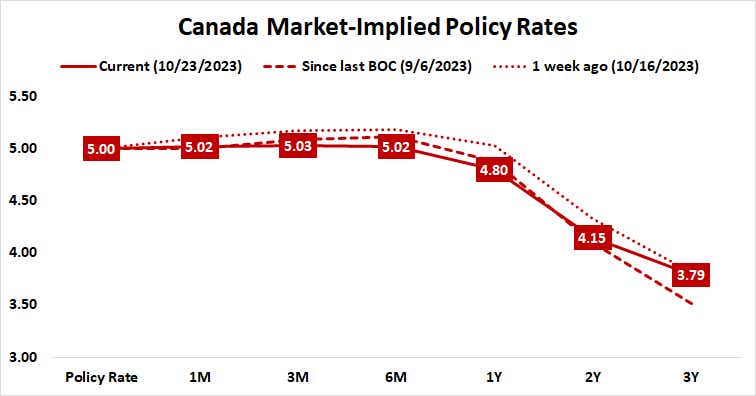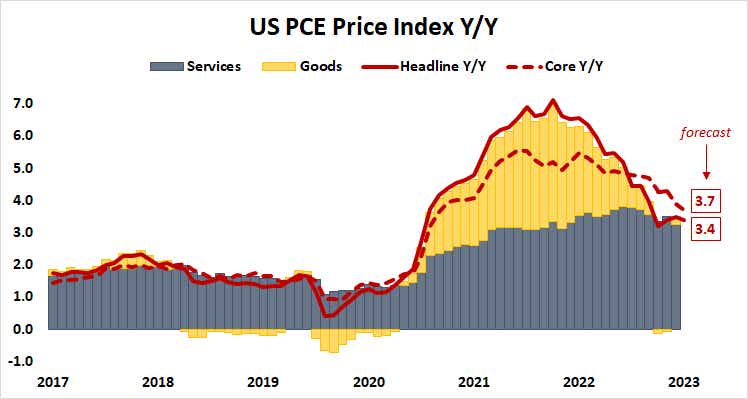ECB and BOC Meetings, Global PMI Data, US PCE Inflation: Macro Week Ahead

ECB and BOC Meetings, Global PMI Data, US PCE Inflation: Macro Week Ahead
By:Ilya Spivak
Stocks will try to recover while the U.S. dollar faces selling pressure as PMI data anchors global recession fears while central banks in Canada and the Eurozone back away from interest rate hikes
- The October PMI data roundup may cheer markets despite signs of economic weakness.
- Central banks in Canada and the Eurozone are set to signal the end of interest rate hikes.
- U.S. PCE inflation data may lift Wall Street absent a hawkish signal for Fed policy.
Financial markets traded against a toxic backdrop last week.
Seething geopolitics sent gold and crude oil prices higher as investors worried that Israel’s clash with Gaza-based terrorist group Hamas will spill over into a broader regional conflict. Meanwhile, Federal Reserve Chair Jerome Powell reiterated the U.S. central bank’s aim to hold rates “higher for longer” even he signaled that the hiking cycle is probably over. That sank Treasury bonds and lifted borrowing costs.
Wall Street did not take kindly to these headwinds. The bellwether S&P 500 stock index shed 2.5%, erasing the previous week’s tepid rise and recording the worst performance in a month.
Here are the key macro waypoints for traders in the week ahead:
Purchasing Managers Index (PMI) surveys
The threat of global recession seemed uncomfortably acute after September’s round of monthly purchasing managers index (PMI) data. Absent a miraculous reprieve, the landscape will probably continue to look challenging when October’s round of updates begins to roll out this week.
Preliminary surveys are due from Japan, Australia, the United Kingdom, the Eurozone and the United States. Final revisions will follow in two weeks.
The key question now is whether more evidence of anemic economic conditions still holds sway with traders. Financial markets are forward-looking. This means that economic weakness by itself is not inherently a hurdle for investors if conditions are not worse than the markets are anticipating.
Data from Citigroup shows global economic data outcomes have increasingly improved relative to forecasts since July. In fact, results now tend toward outperformance relative to baseline forecasts. This means that surprise risk is tilted to the upside on October’s PMI readings, even as the conditions they describe continue to look soft.
Bargain-hunting might ensue against this backdrop, helping support stocks and push back on the U.S. dollar. Underperforming equities in Europe and the emerging markets that have trailed their U.S. counterparts this year may see outsized catch-up gains.

BOC monetary policy meeting
Canada’s central bank is expected to keep its target interest rate unchanged at 5%. The markets expect July’s rate hike to have marked the end of the blistering tightening cycle beginning in March 2022. The Bank of Canada (BOC) is priced in to remain on hold for the better part of a year from here, with cuts starting to emerge toward the end of 2024.
With no changes on the menu, policymakers’ assessment of the economic backdrop and guidance on how they see conditions evolving from here will be in focus. Nearly 80% of Canada’s exports are bound for the U.S. This means that demand south of the border is a defining variable for BOC Governor Tiff Macklem and company. Traders will be eager to weigh up their assessment.

European Central Bank (ECB) monetary policy meeting
Priced in expectations for the path of ECB monetary policy have pointedly shifted to a more dovish setting since the central bank’s September meeting. The markets now see standstill through mid-2024, with rate cuts due thereafter. The first 25-basis-point (bps) reduction is penciled in to appear no later than July.
That makes sense. Leading PMI data implies the regional economy shrank in the third quarter. Meanwhile, inflation dropped to the lowest in almost two years in September. The cost of food – an area where the central bank has little influence – remained the largest contributor to price growth. Excluding that drops the benchmark consumer price index (CPI) measure of inflation from 4.3% to just 2.8%, giving the ECB cover to focus on sluggish demand.
With that in mind, the spotlight will fall on guidance in the policy statement and the press conference with ECB President Christine Lagarde following the meeting of the rate-setting Governing Council. Regional stocks are likely to cheer echoes of the dovish tone shift on display in recent comments from central bank officials.

U.S. Personal Consumption Expenditure (PCE) data
The Federal Reserve’s favored inflation gauge is set to show that core disinflation continued in September, echoing the analog CPI data published earlier this month. Absent an improbably wild deviation from forecasts, the outcomes on offer are unlikely to alter the “hawkish hold” strategy most recently reiterated by Fed Chair Powell last week.
As it stands, the markets expect rates to remain at their current setting through mid-2024. The first 25 bps cut is priced in to occur no later than July. Another reduction is in the cards by November. Wall Street may find relief in results that don’t appear to delay easing any further, while the U.S. dollar might retreat.

Ilya Spivak, tastylive head of global macro, has 15 years of experience in trading strategy, and he specializes in identifying thematic moves in currencies, commodities, interest rates and equities. He hosts Macro Money and co-hosts Overtime, Monday-Thursday. @Ilyaspivak
For live daily programming, market news and commentary, visit tastylive or the YouTube channels tastylive (for options traders), and tastyliveTrending for stocks, futures, forex & macro.
Trade with a better broker, open a tastytrade account today. tastylive, Inc. and tastytrade, Inc. are separate but affiliated companies.
Options involve risk and are not suitable for all investors. Please read Characteristics and Risks of Standardized Options before deciding to invest in options.
tastylive content is created, produced, and provided solely by tastylive, Inc. (“tastylive”) and is for informational and educational purposes only. It is not, nor is it intended to be, trading or investment advice or a recommendation that any security, futures contract, digital asset, other product, transaction, or investment strategy is suitable for any person. Trading securities, futures products, and digital assets involve risk and may result in a loss greater than the original amount invested. tastylive, through its content, financial programming or otherwise, does not provide investment or financial advice or make investment recommendations. Investment information provided may not be appropriate for all investors and is provided without respect to individual investor financial sophistication, financial situation, investing time horizon or risk tolerance. tastylive is not in the business of transacting securities trades, nor does it direct client commodity accounts or give commodity trading advice tailored to any particular client’s situation or investment objectives. Supporting documentation for any claims (including claims made on behalf of options programs), comparisons, statistics, or other technical data, if applicable, will be supplied upon request. tastylive is not a licensed financial adviser, registered investment adviser, or a registered broker-dealer. Options, futures, and futures options are not suitable for all investors. Prior to trading securities, options, futures, or futures options, please read the applicable risk disclosures, including, but not limited to, the Characteristics and Risks of Standardized Options Disclosure and the Futures and Exchange-Traded Options Risk Disclosure found on tastytrade.com/disclosures.
tastytrade, Inc. ("tastytrade”) is a registered broker-dealer and member of FINRA, NFA, and SIPC. tastytrade was previously known as tastyworks, Inc. (“tastyworks”). tastytrade offers self-directed brokerage accounts to its customers. tastytrade does not give financial or trading advice, nor does it make investment recommendations. You alone are responsible for making your investment and trading decisions and for evaluating the merits and risks associated with the use of tastytrade’s systems, services or products. tastytrade is a wholly-owned subsidiary of tastylive, Inc.
tastytrade has entered into a Marketing Agreement with tastylive (“Marketing Agent”) whereby tastytrade pays compensation to Marketing Agent to recommend tastytrade’s brokerage services. The existence of this Marketing Agreement should not be deemed as an endorsement or recommendation of Marketing Agent by tastytrade. tastytrade and Marketing Agent are separate entities with their own products and services. tastylive is the parent company of tastytrade.
tastyfx, LLC (“tastyfx”) is a Commodity Futures Trading Commission (“CFTC”) registered Retail Foreign Exchange Dealer (RFED) and Introducing Broker (IB) and Forex Dealer Member (FDM) of the National Futures Association (“NFA”) (NFA ID 0509630). Leveraged trading in foreign currency or off-exchange products on margin carries significant risk and may not be suitable for all investors. We advise you to carefully consider whether trading is appropriate for you based on your personal circumstances as you may lose more than you invest.
tastycrypto is provided solely by tasty Software Solutions, LLC. tasty Software Solutions, LLC is a separate but affiliate company of tastylive, Inc. Neither tastylive nor any of its affiliates are responsible for the products or services provided by tasty Software Solutions, LLC. Cryptocurrency trading is not suitable for all investors due to the number of risks involved. The value of any cryptocurrency, including digital assets pegged to fiat currency, commodities, or any other asset, may go to zero.
© copyright 2013 - 2025 tastylive, Inc. All Rights Reserved. Applicable portions of the Terms of Use on tastylive.com apply. Reproduction, adaptation, distribution, public display, exhibition for profit, or storage in any electronic storage media in whole or in part is prohibited under penalty of law, provided that you may download tastylive’s podcasts as necessary to view for personal use. tastylive was previously known as tastytrade, Inc. tastylive is a trademark/servicemark owned by tastylive, Inc.